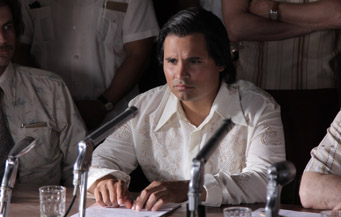BOP Interview: Diego Luna
By Ryan Mazie
March 26, 2014
BoxOfficeProphets.com

The man we are all talking about today is the subject of Luna’s biopic, Cesar Chavez. A late civil rights and labor movement activist in the ‘60s, the film chronicles Chavez’s daunting journey of bringing labor equality to farm workers. Cesar Chavez is a powerful drama that touches on a major turning point in history, centering on non-violent movements and labor issues. It stars Michael Pena, America Ferrara, John Malkovich, and Rosario Dawson, with Luna’s direction bringing the story to life..
Luna touched on why he chose to bring Cesar Chavez’s journey to the screen, shooting in Mexico, cinematography, and how he fit a 10-year movement into 90 minutes of film.
Why did you decide on this project as a director?
I was looking for a project that would connect an audience [in America] to the community [in Mexico]. We wanted to make a bridge between Latin America and the Latino community in the States. There are so many things we have in common and stories we should be sharing, but we have allowed this border to divide us. It’s ridiculous. As Cesar Chavez says, “Our strength is in our numbers,” but we have to accept that there’s more things that connect us… by telling the story of Cesar Chavez and celebrating the legacy of this man.
What does the actor Diego Luna think of the director Diego Luna and vice versa?
As a director I think that there’s a lot for me to learn. I can tell you that my passion is [in directing] today. My hunger, my need for being able to tell the stories I care about, to raise the questions I want to raise. I’m thinking as a director now more than ever. As an actor, I would never hire myself (laughs).
As a filmmaker, what is it like knowing that you are introducing a large portion of your audience to who Cesar Chavez is; directing the first biopic about him?
On one hand, it’s depressing. It’s depressing to be the first film about Cesar Chavez. It’s depressing to celebrate that. We cannot allow ourselves to forget where we come from. Why we are able to be here talking about the story of a Latino leader in this country. The struggle and the work and the fight of [everyone] in the movement needs to be recognized and celebrated. And that’s us.
Even though you shot in Mexico, the location really does match the Central Valley in California. Did you ever think of shooting where it all occurred, or was Mexico always the first choice?
It wasn’t the first choice, but the actual location was never the first choice either, because they look so different from the ‘60s. Technology has arrived through the fields and we would have to use a lot of visual effects and money we didn’t have to alter it… The feeling of immensity or being lost and forgotten, I felt it [in Sonora, Mexico, where we shot the movie]… My point is to be authentic and to do the film we wanted with the freedom I wanted to work with, I had to go to Mexico.
As strong as the story is, your technical aspects are amazing, starting with the cinematography.
I was very lucky to find [cinematographer Enrique Chediak], because he has done big films, but still sees the world from the perspective I see it. He’s from Ecuador and has done little films too and to do more with less and uses creativity to supply what money cannot bring you. In terms of how I wanted the film to look, I said I didn’t care how difficult it is, I am shooting on film. I am not using HD. We went with Super 16, and that brings you into a different era. But we also played a lot with the saturation.
I wanted [the viewer] to feel the struggle from the perspective of a farm worker. It’s very easy to arrive at the fields and to see it and have a feeling that you’re in this gorgeous landscape. Very rich greens, a blue sky, and the sand on the ground give you this feeling of a desert. I didn’t want [the viewer] to feel that. For me, it was very important for the audience to always be reminded that they were there and it wasn’t a choice. They had to be there, because there was no other option, besides running.
You pack a 10 year movement into 90 minutes of film, so how did you decide what particular events you would use?
I knew I didn’t want to do a film that started the day he was born and ended the day that he died, because an hour and 45 minutes can never be enough to show the life of someone. So I decided to concentrate on one achievement and that’s the boycott. Why? Because it’s very pertinent to say that it’s still possible and the only way for a real change to happen. When we engage with consumers and we remember that we are all consumers. Being consumers comes with a responsibility, and if we all know this, then the world would be a better place in a second. We cannot allow indifference to rule our lives. When I buy something, I should know what’s behind it. To me it was very simple and can be applied to any context. I try to make my films connect and that’s the way that I connect with Cesar.
Cesar Chavez is released on March 28th.